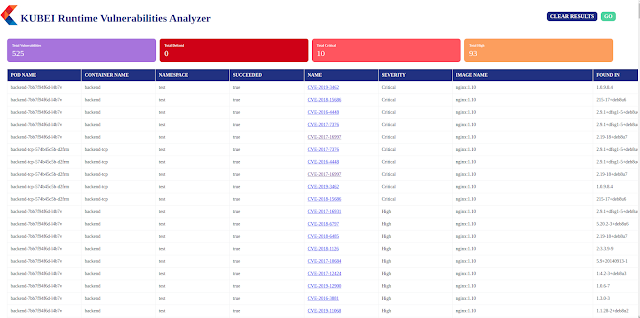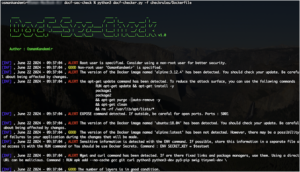Kubei – A Flexible Kubernetes Runtime Scanner

Kubei is a vulnerabilities scanning tool that allows users to get an accurate and immediate risk assessment of their kubernetes clusters. Kubei scans all images that are being used in a Kubernetes cluster, including images of application pods and system pods. It doesn’t scan the entire image registries and doesn’t require preliminary integration with CI/CD pipelines.
It is a configurable tool which allows users to define the scope of the scan (target namespaces), the speed, and the vulnerabilities level of interest.
It provides a graphical UI which allows the viewer to identify where and what should be replaced, in order to mitigate the discovered vulnerabilities.
Prerequisites
- A Kubernetes cluster is ready, and kubeconfig (
~/.kube/config) is properly configured for the target cluster.
Required permissions
- Read secrets in cluster scope. This is required for getting image pull secrets for scanning private image repositories.
- List pods in cluster scope. This is required for calculating the target pods that need to be scanned.
- Create jobs in cluster scope. This is required for creating the jobs that will scan the target pods in their namespaces.
Configurations
The file deploy/kubei.yaml is used to deploy and configure Kubei on your cluster.
- Set the scan scope. Set the
IGNORE_NAMESPACESenv variable to ignore specific namespaces. SetTARGET_NAMESPACEto scan a specific namespace, or leave empty to scan all namespaces. - Set the scan speed. Expedite scanning by running parallel scanners. Set the
MAX_PARALLELISMenv variable for the maximum number of simultaneous scanners. - Set severity level threshold. Vulnerabilities with severity level higher than or equal to
SEVERITY_THRESHOLDthreshold will be reported. Supported levels areUnknown,Negligible,Low,Medium,High,Critical,Defcon1. Default isMedium. - Set the delete job policy. Set the
DELETE_JOB_POLICYenv variable to define whether or not to delete completed scanner jobs. Supported values are:All– All jobs will be deleted.Successful– Only successful jobs will be deleted (default).Never– Jobs will never be deleted.
Usage
- Run the following command to deploy Kubei on the cluster:
kubectl apply -f https://raw.githubusercontent.com/Portshift/kubei/master/deploy/kubei.yaml - Run the following command to verify that Kubei is up and running:
kubectl -n kubei get pod -lapp=kubei
- Then, port forwarding into the Kubei webapp via the following command:
kubectl -n kubei port-forward $(kubectl -n kubei get pods -lapp=kubei -o jsonpath='{.items[0].metadata.name}') 8080 - In your browser, navigate to http://localhost:8080/view/ , and then click ‘GO’ to run a scan.
- To check the state of Kubei, and the progress of ongoing scans, run the following command:
kubectl -n kubei logs $(kubectl -n kubei get pods -lapp=kubei -o jsonpath='{.items[0].metadata.name}') - Refresh the page (http://localhost:8080/view/) to update the results.

Running Kubei with an external HTTP/HTTPS proxy
Uncomment and configure the proxy env variables for the Clair and Kubei deployments in deploy/kubei.yaml.
Limitations
- Supports Kubernetes Image Manifest V 2, Schema 2 (https://docs.docker.com/registry/spec/manifest-v2-2/). It will fail to scan on earlier versions.
- The CVE database will update once a day.
If you like the site, please consider joining the telegram channel or supporting us on Patreon using the button below.




![Brute Ratel C4 Detected - 18[.]177[.]187[.]233:80 7 brute_ratel_c4](https://www.redpacketsecurity.com/wp-content/uploads/2022/07/brute_ratel_c4-300x300.jpg)
![Cobalt Strike Beacon Detected - 118[.]89[.]73[.]78:4433 8 Cobalt-Strike](https://www.redpacketsecurity.com/wp-content/uploads/2021/11/Cobalt-Strike-300x201.jpg)